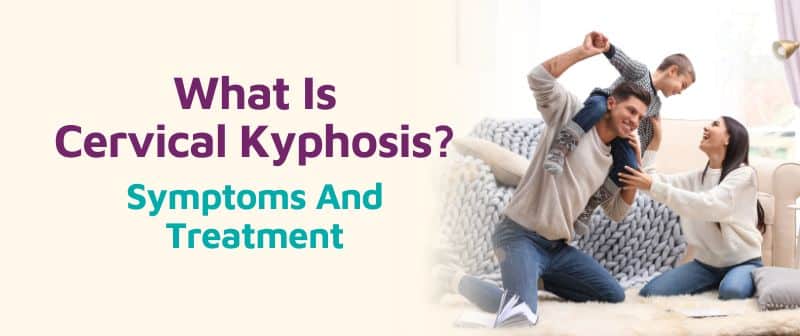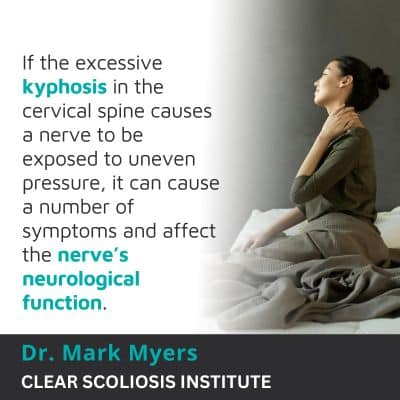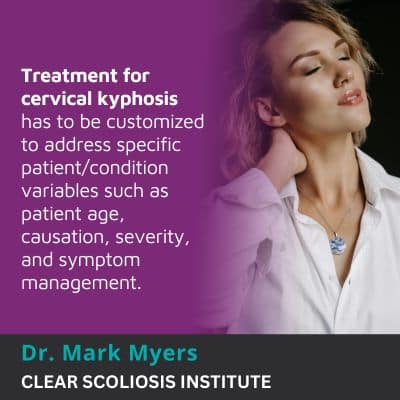
There are three main spinal sections, each with its own characteristics, roles to play in how the spine functions, and type of spinal curvature; the spine’s ability to maintain its natural curves is important because they facilitate a wide range of motion and flexibility, make the spine stronger, and help it to handle mechanical stress from impact and movement.
The cervical spine refers to the neck and contains the first seven vertebrae of the spine. A diagnosis of cervical kyphosis would mean the neck has lost its healthy and natural inward-bending = (shaped curve, instead developing a curve that bends outward: in the opposite direction=) shaped curve.
Let’s start our exploration of cervical kyphosis by first considering the unique roles and structure of the cervical spine.
A healthy cervical spine is important for a number of reasons; it connects the brain to the rest of the body, controls head movement, blood flow to the brain, and has to support the weight of the head and neck.
The spine has three main sections, and the cervical spine refers to the neck; the thoracic spine is the largest section consisting of the middle and upper back, and the lumbar spine refers to the lower back.
As one long complex structure, the health of each individual section is important for the health of the other spinal sections; if a single spinal section loses a healthy curve, it disrupts the biomechanics of the entire spine.
In a healthy spine, its curves are natural and typical, its vertebrae are aligned as they should be, and it’s flexible and strong.
So let’s now take a minute to discuss what makes a spinal curve healthy, and what constitutes an unhealthy spinal curve.
As mentioned earlier, each spinal section has a unique function and curvature type.
The cervical and lumbar spinal sections have what’s known as lordosis: a forward-bending spinal curve that bends toward the body’s center in a standard ‘C’ shape.
The thoracic spine has what’s known as kyphosis: a backward-bending curve that bends away from the body’s center, in a reverse ‘C’ shape.
There is a natural range of curvature sizes that can be considered healthy and typical, but if a spinal curve becomes under-pronounced, over-pronounced, or reverses the natural direction of its bend, the curve has become unhealthy, atypical, and problematic; a healthy range of cervical lordosis would fall between 31 and 45 degrees.
If the cervical spine loses its natural lordosis, this means it can become excessively straight and flattened out, known as military neck, or it can experience a reversal of the curve in which it bends in the opposite direction, become more kyphotic than lordotic: cervical kyphosis.
Each case of cervical kyphosis is unique and can vary in causation, severity, and experienced symptoms.
If the cervical kyphosis is mild, it might not cause noticeable symptoms, but if it’s severe and/or is left untreated, it can cause spinal cord compression and affect the spinal nerves within, or where they exit the spine.

If the excessive kyphosis in the cervical spine causes a nerve to be exposed to uneven pressure, it can cause a number of symptoms and affect the nerve’s neurological function.
Some common symptoms of cervical kyphosis can include:
So we know that when cervical kyphosis occurs, the spinal curve in the neck has become unnatural, bending outwards in a reverse ‘C’ shape, when it’s supposed to bend inwards in a standard wide ‘C’ shape, but what causes this to happen, and what can be done about it?
One of the most common causes of cervical kyphosis is spinal degeneration, and most spinal degeneration starts with the intervertebral discs.
An intervertebral disc sits between adjacent vertebrae providing cushioning during movement (preventing friction), giving the spine structure (adjacent vertebral bodies are attached to the disc in between), flexibility, and acting as the spine’s shock absorbers.
If degenerative disc disease develops in the cervical spine, the change in shape of one disc can affect the position of the vertebrae attached and contribute to the development of an unhealthy spinal curve.
Ankylosing spondylitis is a type of arthritis that causes the joints and ligaments of the spine to become inflamed, over time causing excessive spinal rigidity, and in severe cases, vertebrae can become fused together, and if this develops in the cervical spine, it can cause a reversal of the neck’s healthy lordosis.
Kyphosis can develop in infants from traction forces from the birthing process via forceps, suction or c-section that can pull 90-120 lbs of force on their neck while they are being extracted. That tension on the spinal cord can develop into scoliosis later in adolescents. Kyphosis can also be congenital, meaning babies are born with the condition due to a spine that’s developed typically in utero,this often involves the fusing together of multiple vertebrae and/or vertebral bodies being more triangular in shape, when healthy vertebral bodies are rectangular so they can remain stacked on top of one another (aligned).
Cervical kyphosis can also develop after spinal surgery because of trauma and/or injury.
Treatment for cervical kyphosis has to be customized to address specific patient/condition variables such as patient age, causation, severity, and symptom management.
As a CLEAR-certified chiropractor, my patients benefit from a proactive conservative treatment approach that offers a nonsurgical alternative.
The goal of treatment is to restore as much of the patient’s natural cervical lordosis as possible; that way, the neck’s range of motion and flexibility are improved, and treatment also involves strengthening the muscles that surround the cervical spine so it can be better supported and stabilized.

As the main cause of cervical kyphosis is spinal degeneration, leading a spine-friendly lifestyle can help minimize degenerative changes and protect the health of the intervertebral discs.
If factors such as carrying excess weight or chronic poor posture are contributing to faster rates of spinal degeneration, lifestyle guidance can help, and if the spine has lost its cervical lordosis because of trauma and/or injury, the injury itself has to be treated.
If the presence of an underlying spinal condition is the cause, the condition itself has to be addressed.
When a condition is structural, treatment has to impact it on a structural level, and as the spine’s alignment is improved and its healthy curves are restored, related symptoms are also improved.
Condition-specific chiropractic care can involve a number of techniques and manual adjustments that have the goal of adjusting the position of the cervical spine’s vertebrae so they are in a better position in relation to the rest of the spine’s vertebral bodies (more aligned).
Therapeutic exercises, stretches, and physical therapy can help to relax and strengthen the cervical spine, making it more responsive to treatment, and relaxing and strengthening the neck’s surrounding muscles facilitates optimal support/stabilization for the cervical spine.
Condition-specific exercises and physical therapy can also help improve posture, coordination, and are known to activate specific areas of the brain for better brain-body communication.
Spinal weights can also help with neurological retraining, and soft-tissue remodeling can also help relax and rehabilitate ligaments in the neck for optimal spinal support.
I perform X-rays at the onset and end of treatment to ensure improvements have been made and that the spine can be further rehabilitated and healed for long-term sustainable improvement to spinal health and function.
When it comes to the health of the cervical spine, its ability to maintain a natural and healthy range of lordosis is key.
When the neck loses its healthy creature type, it can become excessively straight, also known as a flattening of the curve and/or military neck, or it can bend in the opposite direction, known as a reverse curve and/or cervical kyphosis.
If a single spinal section’s curve falls beyond a normal and healthy range and becomes problematic, not just the one section is affected, but the entire spine.
Cervical kyphosis can cause a range of symptoms from neck pain to increasing spinal rigidity, less flexibility and range of motion in the neck, tingling sensations, numbness, muscle weakness, headaches, and radiating pain due to nerve compression.
Some cases of cervical kyphosis are minor and don’t produce many overt symptoms, and in general, the more the nerves of the cervical spine are affected, the more noticeable and widespread its symptoms are likely to be.
If particularly severe and/or if left untreated, spinal nerves can have their neurological function disrupted, and the longer a nerve is left irritated, the more damaged it can become, and it can be difficult, if not impossible, to repair damaged nerves; this is why being proactive with treatment can be so beneficial as it can mean preventing further damage.
Treatment for cervical kyphosis will depend on the condition’s underlying cause, severity, and symptoms, but conservative nonsurgical treatment can involve condition-specific chiropractic care that works towards repositioning specific vertebrae in the cervical spine, physical therapy, a variety of therapies, and specific exercises that work towards improving spinal support through strengthening the neck’s surrounding muscles, improving posture, spinal strength, flexibility, and retraining the brain.
The best take-away here is that leading a spine-friendly lifestyle can help protect the spine’s natural curves and alignment, and this can include maintaining a healthy weight and activity level, practicing good posture, and making sure that heavy objects aren’t being lifted in a way that strains the spine.
Being mindful of screen time and looking down at devices can also help preserve the health of the cervical spine; forward head posture can develop from constantly bending the neck downwards without taking breaks, looking up, and stretching the neck properly.
Spinal degeneration is part of aging, but practicing a spine-friendly lifestyle can help slow the rate of level of degenerative changes.

CLEAR provides a unique and innovative way of understanding scoliosis. Sign up to receive facts and information you won’t find anywhere else.
